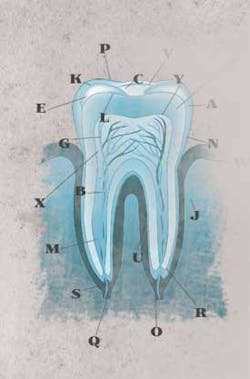ACP, CPP-ACP, F, and Calcium Carbonate Aginine Bicarbonate and Xylitol, Oh My!
We now have a longer list of products that can help us remineralize in ways we couldn't before: that is from the bottom up, creating beautiful enamel.
Confusion, thy name is remineralization. Hygienists and dentists across the continent develop spinning heads, rolling eyes, and lolling tongues when it comes to remineralization of enamel. Fluoride used to be the way to remineralize teeth, and the clinician would clap her hands once and put her palms in the air, cheerleader style, and call it good.
We now have a longer list of products that can help us remineralize in ways we couldn't before: that is from the bottom up, creating beautiful enamel. Remember that enamel breaks down under the surface first. Then after some time, the top layer caves in, creating a hole.
Fluoride
Let's start with the ol' tried-n-true — fluoride. We've known for a long time that fluoride works on the surface of enamel, and works better on the broad surfaces of teeth as compared to the pits and fissures. For an elaborate explanation and intricate discussion on fluoride, read Dr. Featherstone's article in the July 2000 JADA.
Fluoride is best when used frequently in small doses. It gives the enamel a chance to rebuild the fluorohydroxyapatite molecules that are acid-resistant. That's why fluoridated water works; it's a low dose of fluoride going over the teeth, giving the enamel a chance to seal off that top layer.
Office treatments have evolved and devolved, from four-minute gel tray application, to one-minute foam, back to four minutes. The ADA suggests that all office fluoride treatments should be applied to teeth for at least four minutes. We also have fluoride varnish that is the only fluoride known to be effective in pits and fissures. Glass ionomer sealants are also good for fluoride application because they provide fluoride for the longest time.
One of the limitations of fluoride is the way it seals off the superficial surface of the tooth. Generically speaking, when we say fluoride works on the surface, that white bracket footprint on the teeth will remain even after fluoridating the enamel because the demineralization takes place under the surface. When a white spot is evident, fluoride may not be the best option.
When and Who: Everyone who has teeth can benefit from fluoride in low amounts throughout the day. For remineralization, fluoride could be used last, after the lesion has been filled in with other products. The only people who are not the best candidates for fluoride are children under six.
How: Not rinsing off fluoridated toothpaste is a great way to increase application. Using Lozi-Flur fluoride lozenges is another terrific way to administer a low-dose, long duration application.
Fluoride toxicity is not often discussed because deaths from fluoride overdose seldom happen, and most times the fluoride is not from oral care products. However, with the increased use of fluoride varnishes, it may be worth mentioning because of its high concentration. Symptoms include hypersalivation, headache, muscular spasm, nausea, vomiting, tremors, diarrhea, titanic contractions, abdominal pain, hyperactive reflexes, dysphasia, and muscle weakness.
ACP
The next option we have for remineralization is amorphous calcium phosphate (ACP). ACP can fill the lesion from the bottom up, and provide the tooth with its natural color and translucency. ACP products are advertised for sensitivity. This is a cosmetic claim, but as dental health-care providers we can take the science of the material and repurpose it to work for us. If you understand the science of enamel building or rebuilding, you understand that the amorphous configuration of calcium and phosphate can hook up with fluoride to create the fluorohydroxyapatite (sometimes called fluorapatite or hydroxyfluorapatite).
ACP in this configuration has no substantivity, so at the next acid challenge (the critical pH of 5.5) the breakdown will occur and there won't be any extra ACP to help remineralization. If the saliva is healthy, this may be a good way to supplement.
ACP can be found in Enamel Care toothpaste by Arm and Hammer, Enamel Pro by Premier, Nite White ACP by Discus, and Aegis pit and fissure sealant, Aegis crown and bridge cement, and Aegis orthodontic adhesive with ACP, all by Bosworth.
When and Who: The best candidates are people with mild remineralization problems and high motivation. The sealant materials can be a way to skirt compliance issues by having the ACP at the high-risk site.
How: Apply ACP products whenever it's convenient. Tray applications are helpful for full mouth treatment.
CPP-ACP
CPP-ACP is the next level for remineralization. Where ACP has low substantivity, the casein phosphopeptide (CPP) creates a molecule of ACP surrounded by CPP that hangs around for over six hours. The CPP is a milk protein that makes the ACP sticky and allows it to hang around. The beauty of this product, called Recaldent, is its ability to change the pH at the point of the acid challenge. Recaldent is now found in three products —the flagship Recaldent product Trident White, MI Paste and MI Paste Plus with fluoride, both by GC America.
When and Who: The best candidates are people with poor or no saliva, people with white spot infections (lesions), children, and athletes, who have dry mouth from exertion breathing.
How: It should be used at least once or twice per day and applied with the fingertip or double cotton tip applicators. At the office it can be applied with a prophy cup with outside webbing like Young Dental's Elite cup.
SensiStat
One other sensitivity product is helpful in healing enamel. It's called SensiStat, which can be found in DenClude Desensitizing Dental Cream, and again focuses on cosmetic benefits. The active ingredients in SensiStat are calcium carbonate and bicarbonate, which effectively block the dentinal tubules. To help the process along, aginine is added, which stimulates basophilic bacteria and crowds out the acidophilic bacteria and ups the environmental pH. Acidophilic bacteria cannot thrive in a high or normal pH.
When and Who: This is for people who have poor quality saliva to increase their pH.
How: Apply regular toothpaste with a toothbrush, and do not rinse.
Xylitol
Xylitol is another really fun thing to talk about regarding remineralization of teeth. It doesn't act on the teeth directly, although some studies show it attracts calcium. Xylitol acts directly on bacteria. Because it's a polyol, it isn't metabolized by trouble-causing bacteria. The xylitol takes residence in the location normally reserved for fructose in the metabolism cycle. Acids are not produced, which shifts the environment to favor bacteria that don't cause enamel breakdown. The germs eventually die, and the niche is filled with healthy bacterium.
The new biofilm is not as harmful, and all is right with the world. For remineralization protocols, xylitol is a must.
When and Who: If the decay is in a young child, the whole family should be using xylitol to focus on the infectious nature of the disease, not just the hole.
How: The current suggestion is to use between six and 10 grams of xylitol a day, which is a little over six to 10 servings of gum. Look for xylitol as the only or as one of the top three sweeteners in a gum. Xylitol can be found in gums, candies, mints, toothpastes, mouthwashes, nasal spray, wipes, and gels.
About the Author
Shirley Gutkowski, RDH, BSDH, FACE, is co-director of CareerFusion and a practicing dental hygienist. She is co-author of the best selling book, "The Purple Guide: Developing Your Clinical Dental Hygiene Career" with Amy Nieves, RDH. She can be contacted at [email protected].






